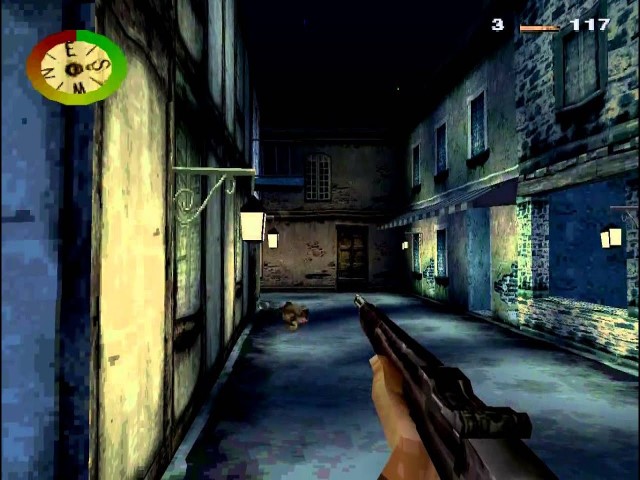
If you saw (and loved) Saving Private Ryan and wanted it to be a video game, you’re in luck. Medal of Honor, from Dreamworks, has transformed World War II into a first-person shooter for the PlayStation. Although it’s decidedly less graphic than Saving Private Ryan, you can still get a fair idea of what it might be like to be a member of the O.S.S. in WWII.
You take on the role of Sgt. James Patterson, who’s been recruited into the O.S.S. because of his marksman skills and quick wit. You’re given 7 missions to accomplish, each of which is made up of several levels. Some missions require you to find something. Others have you doing demolition work. You’ll sometimes go undercover, wearing the uniform of a German officer to get inside enemy headquarters. In every case, you’ll carry a number of weapons with you, ranging from a small, silenced pistol to a bazooka.
From the moment you boot your PlayStation, it’s very apparent that a lot of work went into the overall presentation of the game. From the packaging to the game’s loading screens, everything has a 1940s look and feel. Even the game’s save screen is made to look like a confidential O.S.S. document. The level designs are some of the best I’ve seen in a console first-person shooter. The layouts are logical while remaining challenging. The enemy soldiers may not look great compared to other games, but the artificial intelligence that drives them is second to none. Throw a grenade at a soldier and he doesn’t just stand there and die. Nope. He might run away or pick it up and throw it right back at you. He’s definitely not going to die like a lifeless stick figure. When you’re undercover and suddenly pull a gun on a soldier, he might exclaim, “Sir, you’re confusing me!”
Medal of Honor also excels in the sound department. The background music is a full, orchestral soundtrack that sounds like it was scored by John Williams. It wasn’t, but it’s so good you can actually buy the CD soundtrack for the game. The sound effects are chillingly atmospheric. You’ll hear German voices all around you in the cold, night air as you sneak around a town late at night. You’ll hear the dogs that are chasing you through a sewer system as if they’re right behind you. The sound effects, along with the music, really add to the experience that the game works so hard at creating.
The game’s 3D graphics are very ambitious, but are let down by the aging PlayStation hardware. The game’s levels are very dark and suffer from extreme pixelization. When in the distance, enemy soldiers seem to emerge from a fog bank and then retreat again. Once, while looking through the game’s sniper scope, I watched soldiers on a bridge run back and forth in one spot, disappearing and reappearing as if they were cloaking and de-cloaking like in “Star Trek.” Another graphical quirk occurs with bullet holes that will hang in mid air occasionally. Really, though, these are minor quibbles considering that they affect the game’s atmosphere more than the actual gameplay. It’s just a shame that the game’s lofty goals of creating such a lush and immersive experience are let down by a five-year old console’s graphical limitations.
The controls are pretty good, considering that first-person shooters tend to lend themselves to a much more complicated (and flexible) control set-up than a single PlayStation controller can provide. Although the Dual Shock controller isn’t a match for a mouse and a keyboard, Dreamworks has done a very good job getting the most from the controller. The left analog stick moves you forward and backward, with the speed controlled by the angle of the stick. The right analog stick controls your vision. The X button is the “shoot” button. The square controls any actions that may need done, like opening doors and setting explosives. The circle button cycles through your weapons and triangle button is the jump button. Strafing is done via the L1 and R1 buttons. L2 is a crawl/crouch button and R2 is a look/aim button. On a standard controller, the look/aim function becomes critical, as it makes up for the lack of the right analog stick. There is a problem with the game’s programming that causes the analog controller to shut off periodically. It’s damn unnerving when you’re trying to line up a shot and realize that you’ve got enemy soldiers bearing down on you and the controller’s not responding. I spent a lot of time playing with a standard controller and that alleviated the problem for me.
The biggest problem with this game is that — since it is so well-crafted — the minor problems stick out more than they would on a lesser title. On a console with a bit more horsepower, this could have been one of the greatest first-person shooters ever. For now, it has to settle for being the greatest PlayStation first-person shooter ever. That’s still not such a bad thing.
If you’ve got the slightest notion of playing Army on your PlayStation, forget the Army Men series and pick up this game. Medal of Honor deserves a place in your PlayStation collection.

